Critical Analysis: Legal & Professional Issues in Nursing (ICU)
VerifiedAdded on 2023/06/03
|10
|2974
|261
Essay
AI Summary
This essay provides a comprehensive overview of the legal and professional issues encountered in nursing, with a specific focus on cardiac thoracic patients in the Intensive Care Unit (ICU). It addresses key concerns such as patient rights, data confidentiality under HIPAA, and the potential for medical errors, highlighting the importance of evidence-based practice and ethical considerations. The essay further explores the concept of confidentiality, its implications, and the ethical dilemmas nurses face in balancing patient privacy with the need for effective care. Additionally, it includes a personal reflection on health, illness, and dying, as well as the application of the five rights of medication administration to ensure patient safety in the ICU. The document emphasizes the need for healthcare professionals to uphold patient rights, maintain confidentiality, and adhere to ethical guidelines to provide high-quality care while minimizing legal risks. Desklib offers similar solved assignments and past papers for students.
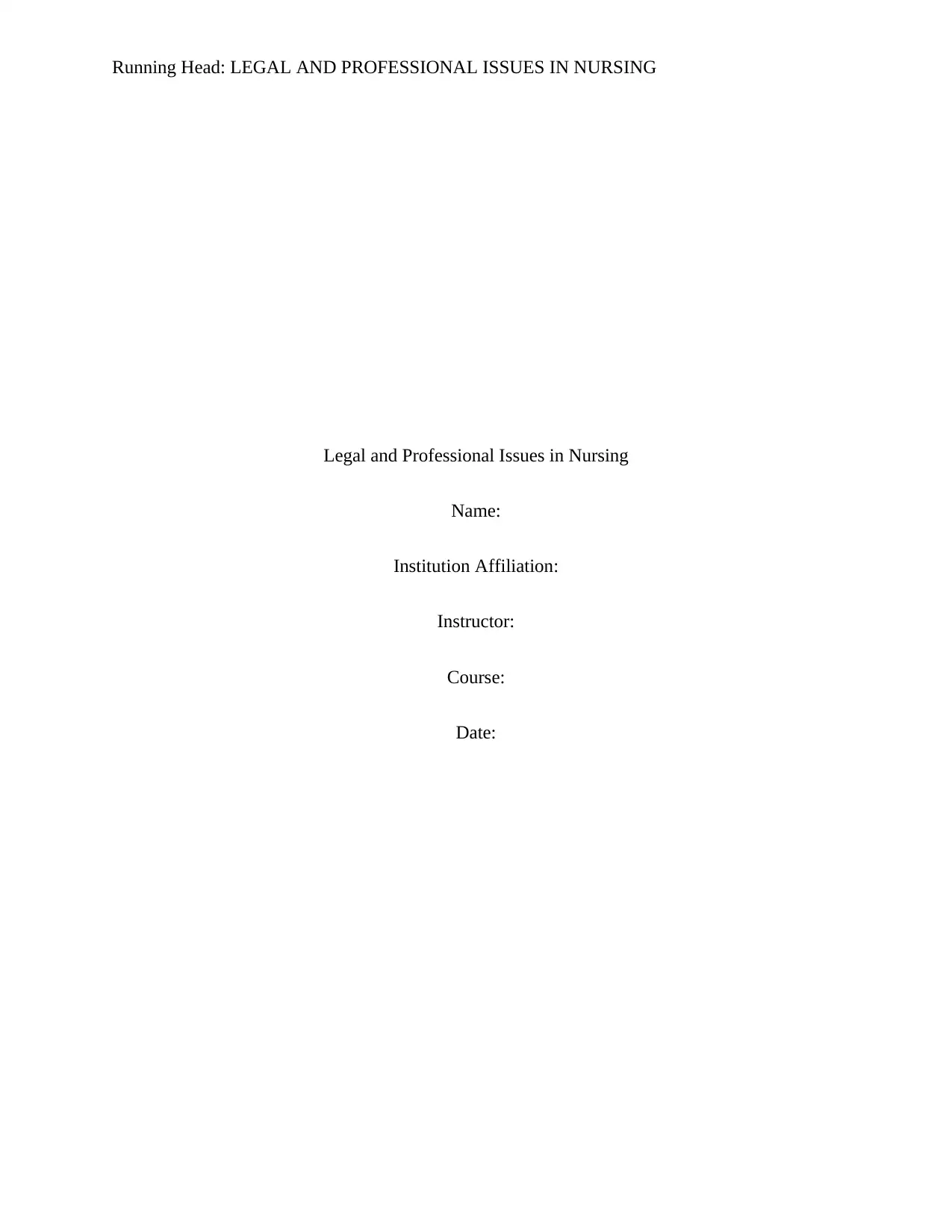
Running Head: LEGAL AND PROFESSIONAL ISSUES IN NURSING
Legal and Professional Issues in Nursing
Name:
Institution Affiliation:
Instructor:
Course:
Date:
Legal and Professional Issues in Nursing
Name:
Institution Affiliation:
Instructor:
Course:
Date:
Paraphrase This Document
Need a fresh take? Get an instant paraphrase of this document with our AI Paraphraser
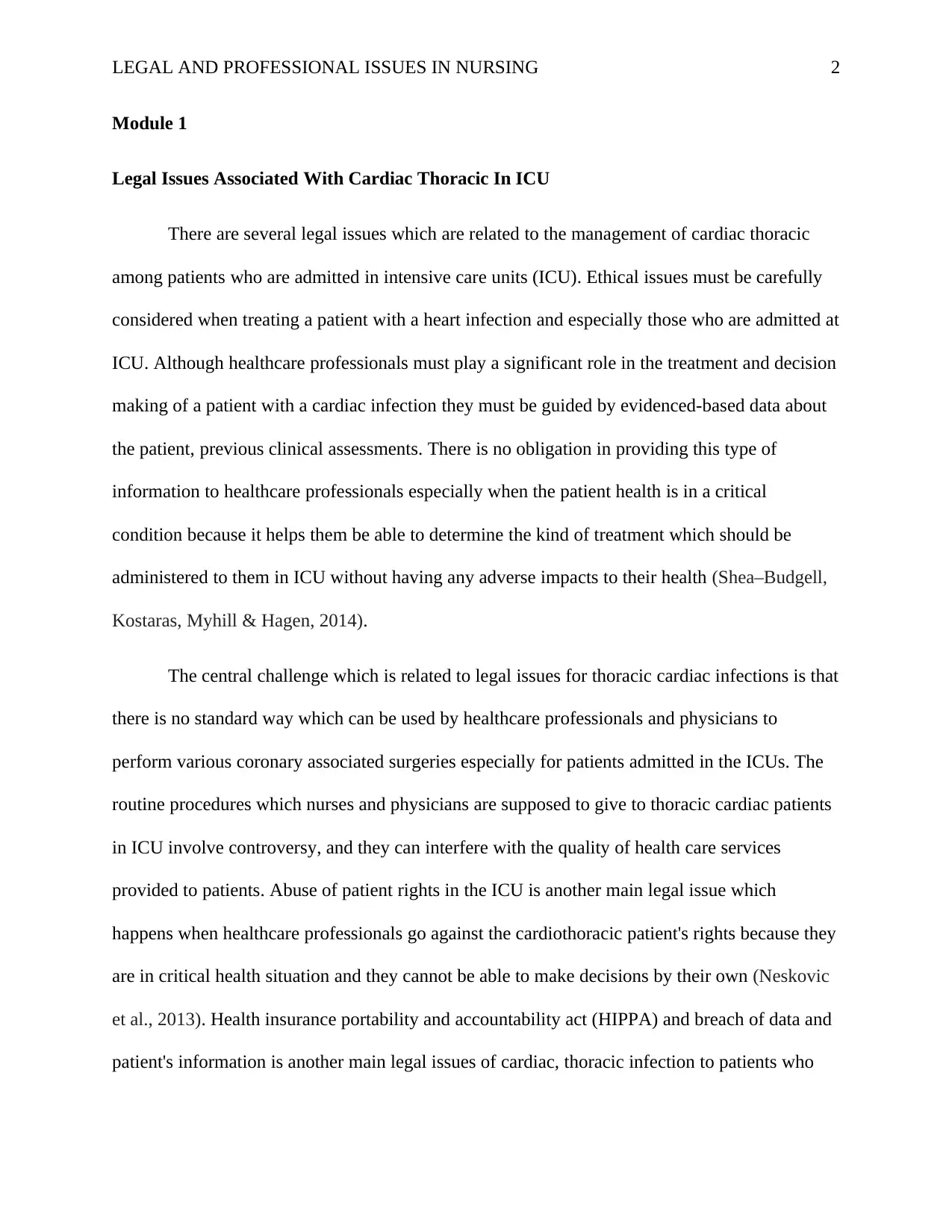
LEGAL AND PROFESSIONAL ISSUES IN NURSING 2
Module 1
Legal Issues Associated With Cardiac Thoracic In ICU
There are several legal issues which are related to the management of cardiac thoracic
among patients who are admitted in intensive care units (ICU). Ethical issues must be carefully
considered when treating a patient with a heart infection and especially those who are admitted at
ICU. Although healthcare professionals must play a significant role in the treatment and decision
making of a patient with a cardiac infection they must be guided by evidenced-based data about
the patient, previous clinical assessments. There is no obligation in providing this type of
information to healthcare professionals especially when the patient health is in a critical
condition because it helps them be able to determine the kind of treatment which should be
administered to them in ICU without having any adverse impacts to their health (Shea–Budgell,
Kostaras, Myhill & Hagen, 2014).
The central challenge which is related to legal issues for thoracic cardiac infections is that
there is no standard way which can be used by healthcare professionals and physicians to
perform various coronary associated surgeries especially for patients admitted in the ICUs. The
routine procedures which nurses and physicians are supposed to give to thoracic cardiac patients
in ICU involve controversy, and they can interfere with the quality of health care services
provided to patients. Abuse of patient rights in the ICU is another main legal issue which
happens when healthcare professionals go against the cardiothoracic patient's rights because they
are in critical health situation and they cannot be able to make decisions by their own (Neskovic
et al., 2013). Health insurance portability and accountability act (HIPPA) and breach of data and
patient's information is another main legal issues of cardiac, thoracic infection to patients who
Module 1
Legal Issues Associated With Cardiac Thoracic In ICU
There are several legal issues which are related to the management of cardiac thoracic
among patients who are admitted in intensive care units (ICU). Ethical issues must be carefully
considered when treating a patient with a heart infection and especially those who are admitted at
ICU. Although healthcare professionals must play a significant role in the treatment and decision
making of a patient with a cardiac infection they must be guided by evidenced-based data about
the patient, previous clinical assessments. There is no obligation in providing this type of
information to healthcare professionals especially when the patient health is in a critical
condition because it helps them be able to determine the kind of treatment which should be
administered to them in ICU without having any adverse impacts to their health (Shea–Budgell,
Kostaras, Myhill & Hagen, 2014).
The central challenge which is related to legal issues for thoracic cardiac infections is that
there is no standard way which can be used by healthcare professionals and physicians to
perform various coronary associated surgeries especially for patients admitted in the ICUs. The
routine procedures which nurses and physicians are supposed to give to thoracic cardiac patients
in ICU involve controversy, and they can interfere with the quality of health care services
provided to patients. Abuse of patient rights in the ICU is another main legal issue which
happens when healthcare professionals go against the cardiothoracic patient's rights because they
are in critical health situation and they cannot be able to make decisions by their own (Neskovic
et al., 2013). Health insurance portability and accountability act (HIPPA) and breach of data and
patient's information is another main legal issues of cardiac, thoracic infection to patients who
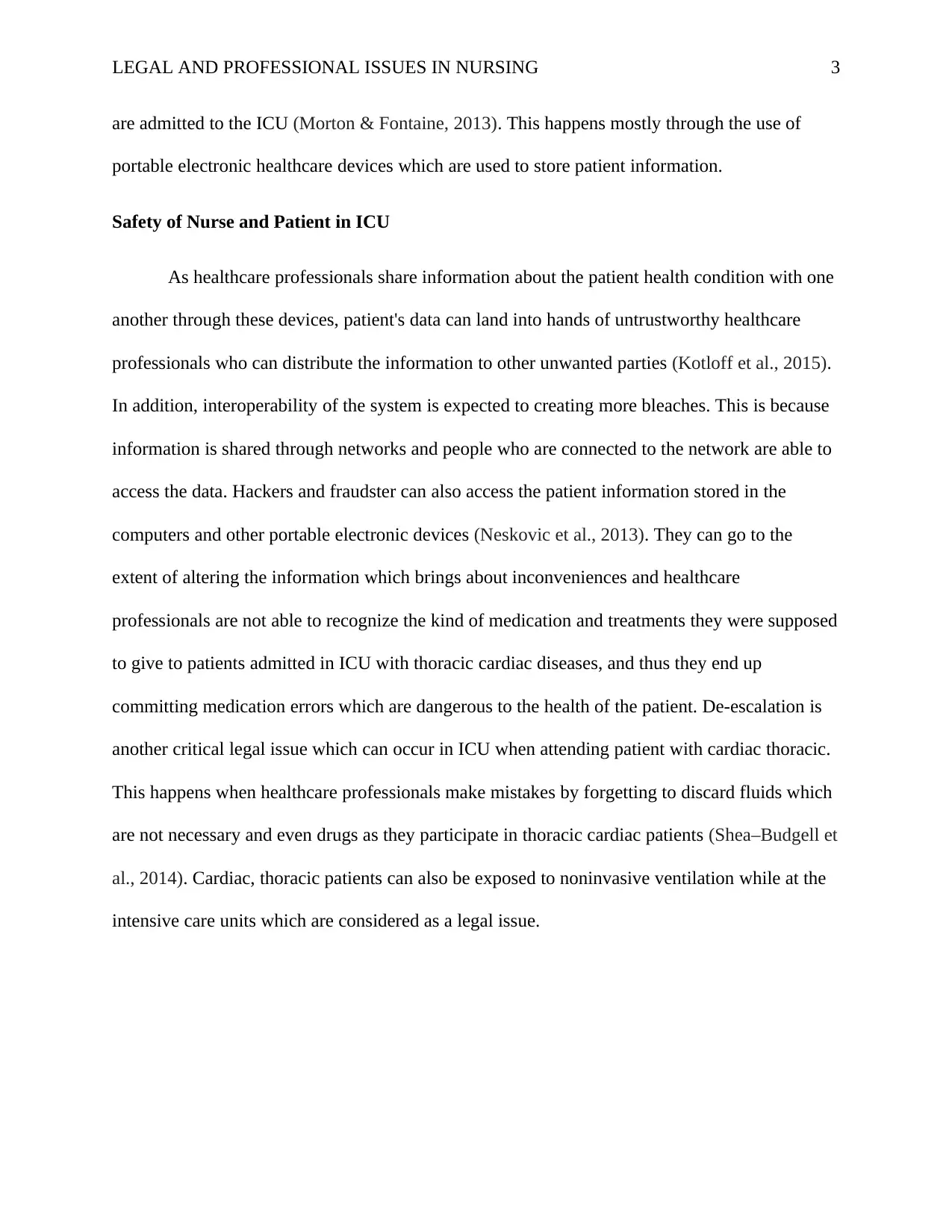
LEGAL AND PROFESSIONAL ISSUES IN NURSING 3
are admitted to the ICU (Morton & Fontaine, 2013). This happens mostly through the use of
portable electronic healthcare devices which are used to store patient information.
Safety of Nurse and Patient in ICU
As healthcare professionals share information about the patient health condition with one
another through these devices, patient's data can land into hands of untrustworthy healthcare
professionals who can distribute the information to other unwanted parties (Kotloff et al., 2015).
In addition, interoperability of the system is expected to creating more bleaches. This is because
information is shared through networks and people who are connected to the network are able to
access the data. Hackers and fraudster can also access the patient information stored in the
computers and other portable electronic devices (Neskovic et al., 2013). They can go to the
extent of altering the information which brings about inconveniences and healthcare
professionals are not able to recognize the kind of medication and treatments they were supposed
to give to patients admitted in ICU with thoracic cardiac diseases, and thus they end up
committing medication errors which are dangerous to the health of the patient. De-escalation is
another critical legal issue which can occur in ICU when attending patient with cardiac thoracic.
This happens when healthcare professionals make mistakes by forgetting to discard fluids which
are not necessary and even drugs as they participate in thoracic cardiac patients (Shea–Budgell et
al., 2014). Cardiac, thoracic patients can also be exposed to noninvasive ventilation while at the
intensive care units which are considered as a legal issue.
are admitted to the ICU (Morton & Fontaine, 2013). This happens mostly through the use of
portable electronic healthcare devices which are used to store patient information.
Safety of Nurse and Patient in ICU
As healthcare professionals share information about the patient health condition with one
another through these devices, patient's data can land into hands of untrustworthy healthcare
professionals who can distribute the information to other unwanted parties (Kotloff et al., 2015).
In addition, interoperability of the system is expected to creating more bleaches. This is because
information is shared through networks and people who are connected to the network are able to
access the data. Hackers and fraudster can also access the patient information stored in the
computers and other portable electronic devices (Neskovic et al., 2013). They can go to the
extent of altering the information which brings about inconveniences and healthcare
professionals are not able to recognize the kind of medication and treatments they were supposed
to give to patients admitted in ICU with thoracic cardiac diseases, and thus they end up
committing medication errors which are dangerous to the health of the patient. De-escalation is
another critical legal issue which can occur in ICU when attending patient with cardiac thoracic.
This happens when healthcare professionals make mistakes by forgetting to discard fluids which
are not necessary and even drugs as they participate in thoracic cardiac patients (Shea–Budgell et
al., 2014). Cardiac, thoracic patients can also be exposed to noninvasive ventilation while at the
intensive care units which are considered as a legal issue.
⊘ This is a preview!⊘
Do you want full access?
Subscribe today to unlock all pages.

Trusted by 1+ million students worldwide
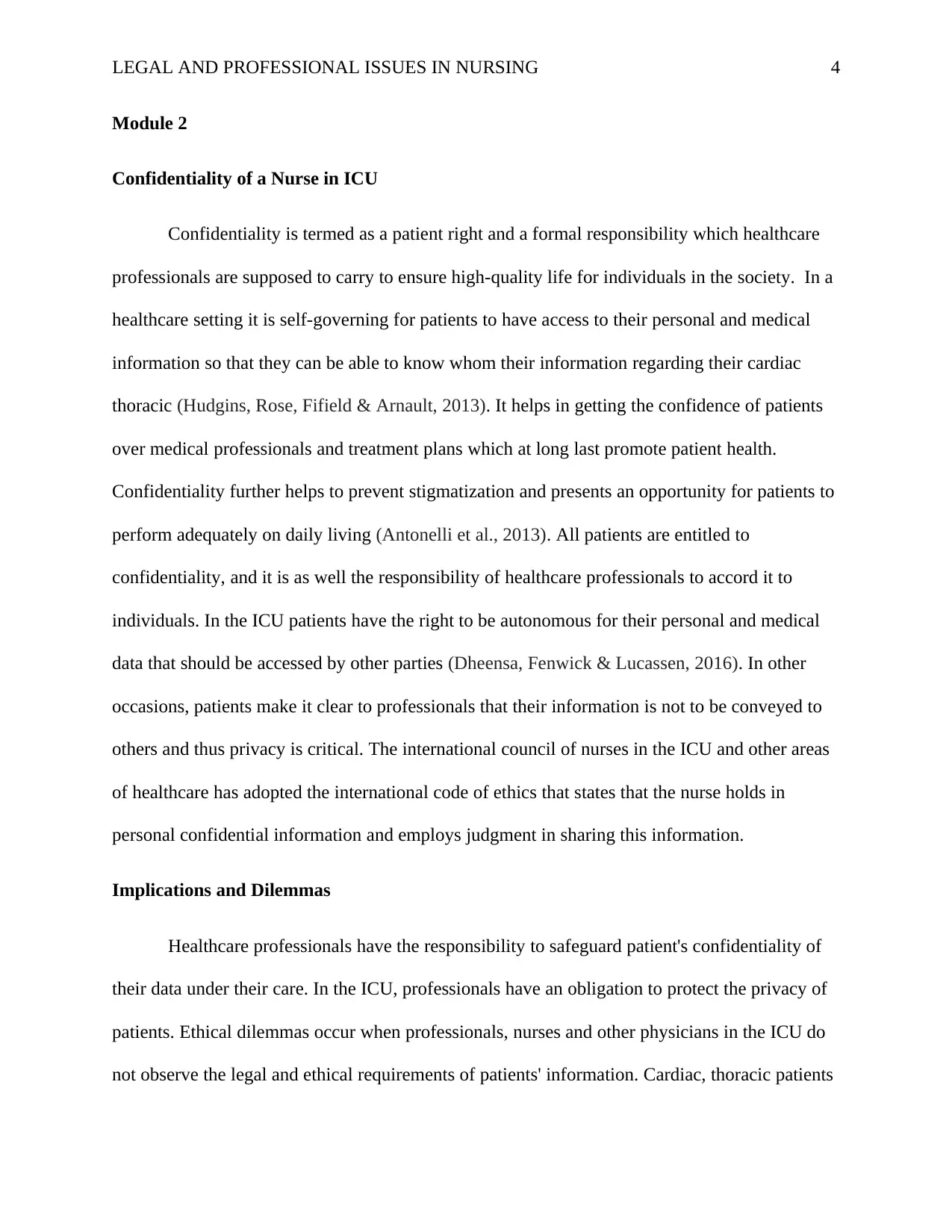
LEGAL AND PROFESSIONAL ISSUES IN NURSING 4
Module 2
Confidentiality of a Nurse in ICU
Confidentiality is termed as a patient right and a formal responsibility which healthcare
professionals are supposed to carry to ensure high-quality life for individuals in the society. In a
healthcare setting it is self-governing for patients to have access to their personal and medical
information so that they can be able to know whom their information regarding their cardiac
thoracic (Hudgins, Rose, Fifield & Arnault, 2013). It helps in getting the confidence of patients
over medical professionals and treatment plans which at long last promote patient health.
Confidentiality further helps to prevent stigmatization and presents an opportunity for patients to
perform adequately on daily living (Antonelli et al., 2013). All patients are entitled to
confidentiality, and it is as well the responsibility of healthcare professionals to accord it to
individuals. In the ICU patients have the right to be autonomous for their personal and medical
data that should be accessed by other parties (Dheensa, Fenwick & Lucassen, 2016). In other
occasions, patients make it clear to professionals that their information is not to be conveyed to
others and thus privacy is critical. The international council of nurses in the ICU and other areas
of healthcare has adopted the international code of ethics that states that the nurse holds in
personal confidential information and employs judgment in sharing this information.
Implications and Dilemmas
Healthcare professionals have the responsibility to safeguard patient's confidentiality of
their data under their care. In the ICU, professionals have an obligation to protect the privacy of
patients. Ethical dilemmas occur when professionals, nurses and other physicians in the ICU do
not observe the legal and ethical requirements of patients' information. Cardiac, thoracic patients
Module 2
Confidentiality of a Nurse in ICU
Confidentiality is termed as a patient right and a formal responsibility which healthcare
professionals are supposed to carry to ensure high-quality life for individuals in the society. In a
healthcare setting it is self-governing for patients to have access to their personal and medical
information so that they can be able to know whom their information regarding their cardiac
thoracic (Hudgins, Rose, Fifield & Arnault, 2013). It helps in getting the confidence of patients
over medical professionals and treatment plans which at long last promote patient health.
Confidentiality further helps to prevent stigmatization and presents an opportunity for patients to
perform adequately on daily living (Antonelli et al., 2013). All patients are entitled to
confidentiality, and it is as well the responsibility of healthcare professionals to accord it to
individuals. In the ICU patients have the right to be autonomous for their personal and medical
data that should be accessed by other parties (Dheensa, Fenwick & Lucassen, 2016). In other
occasions, patients make it clear to professionals that their information is not to be conveyed to
others and thus privacy is critical. The international council of nurses in the ICU and other areas
of healthcare has adopted the international code of ethics that states that the nurse holds in
personal confidential information and employs judgment in sharing this information.
Implications and Dilemmas
Healthcare professionals have the responsibility to safeguard patient's confidentiality of
their data under their care. In the ICU, professionals have an obligation to protect the privacy of
patients. Ethical dilemmas occur when professionals, nurses and other physicians in the ICU do
not observe the legal and ethical requirements of patients' information. Cardiac, thoracic patients
Paraphrase This Document
Need a fresh take? Get an instant paraphrase of this document with our AI Paraphraser
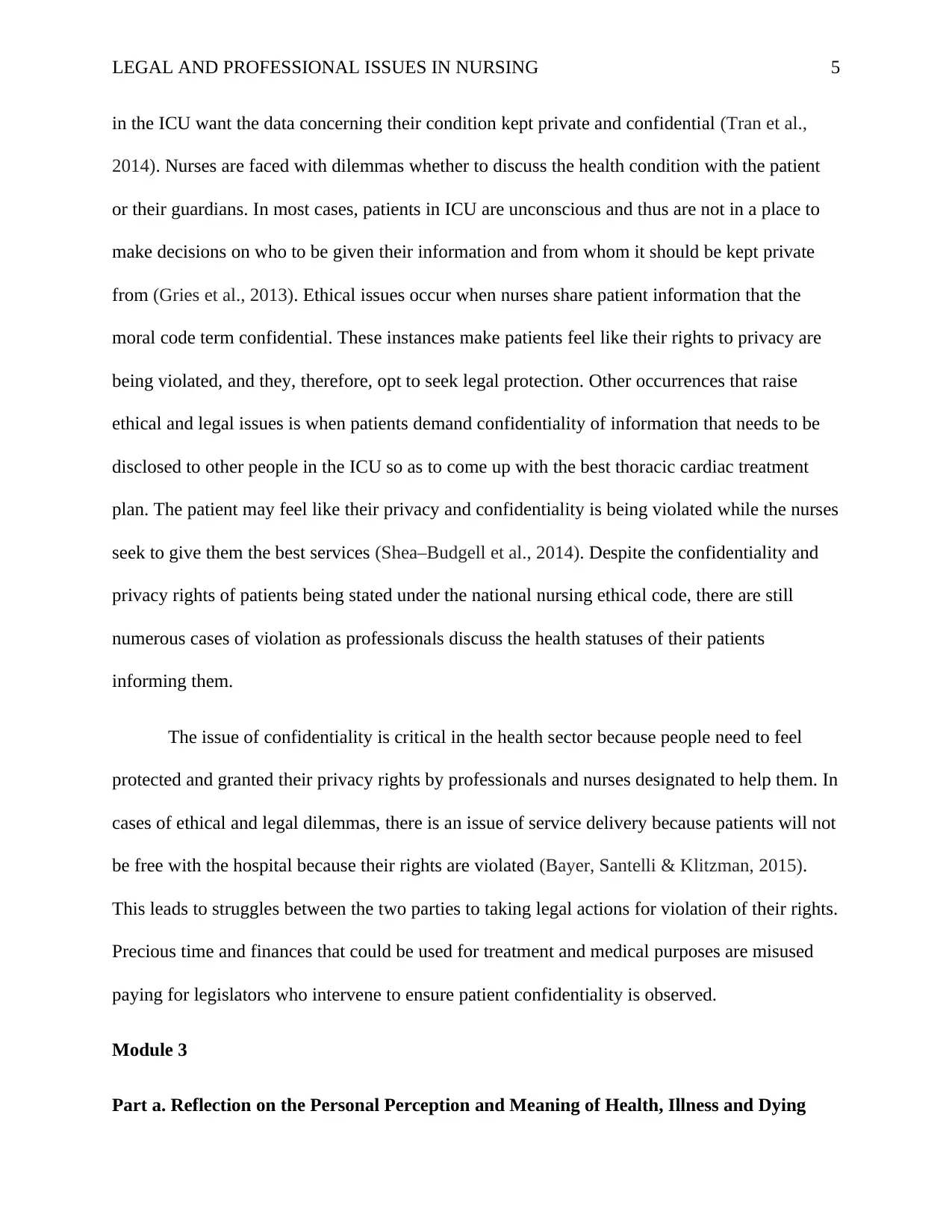
LEGAL AND PROFESSIONAL ISSUES IN NURSING 5
in the ICU want the data concerning their condition kept private and confidential (Tran et al.,
2014). Nurses are faced with dilemmas whether to discuss the health condition with the patient
or their guardians. In most cases, patients in ICU are unconscious and thus are not in a place to
make decisions on who to be given their information and from whom it should be kept private
from (Gries et al., 2013). Ethical issues occur when nurses share patient information that the
moral code term confidential. These instances make patients feel like their rights to privacy are
being violated, and they, therefore, opt to seek legal protection. Other occurrences that raise
ethical and legal issues is when patients demand confidentiality of information that needs to be
disclosed to other people in the ICU so as to come up with the best thoracic cardiac treatment
plan. The patient may feel like their privacy and confidentiality is being violated while the nurses
seek to give them the best services (Shea–Budgell et al., 2014). Despite the confidentiality and
privacy rights of patients being stated under the national nursing ethical code, there are still
numerous cases of violation as professionals discuss the health statuses of their patients
informing them.
The issue of confidentiality is critical in the health sector because people need to feel
protected and granted their privacy rights by professionals and nurses designated to help them. In
cases of ethical and legal dilemmas, there is an issue of service delivery because patients will not
be free with the hospital because their rights are violated (Bayer, Santelli & Klitzman, 2015).
This leads to struggles between the two parties to taking legal actions for violation of their rights.
Precious time and finances that could be used for treatment and medical purposes are misused
paying for legislators who intervene to ensure patient confidentiality is observed.
Module 3
Part a. Reflection on the Personal Perception and Meaning of Health, Illness and Dying
in the ICU want the data concerning their condition kept private and confidential (Tran et al.,
2014). Nurses are faced with dilemmas whether to discuss the health condition with the patient
or their guardians. In most cases, patients in ICU are unconscious and thus are not in a place to
make decisions on who to be given their information and from whom it should be kept private
from (Gries et al., 2013). Ethical issues occur when nurses share patient information that the
moral code term confidential. These instances make patients feel like their rights to privacy are
being violated, and they, therefore, opt to seek legal protection. Other occurrences that raise
ethical and legal issues is when patients demand confidentiality of information that needs to be
disclosed to other people in the ICU so as to come up with the best thoracic cardiac treatment
plan. The patient may feel like their privacy and confidentiality is being violated while the nurses
seek to give them the best services (Shea–Budgell et al., 2014). Despite the confidentiality and
privacy rights of patients being stated under the national nursing ethical code, there are still
numerous cases of violation as professionals discuss the health statuses of their patients
informing them.
The issue of confidentiality is critical in the health sector because people need to feel
protected and granted their privacy rights by professionals and nurses designated to help them. In
cases of ethical and legal dilemmas, there is an issue of service delivery because patients will not
be free with the hospital because their rights are violated (Bayer, Santelli & Klitzman, 2015).
This leads to struggles between the two parties to taking legal actions for violation of their rights.
Precious time and finances that could be used for treatment and medical purposes are misused
paying for legislators who intervene to ensure patient confidentiality is observed.
Module 3
Part a. Reflection on the Personal Perception and Meaning of Health, Illness and Dying
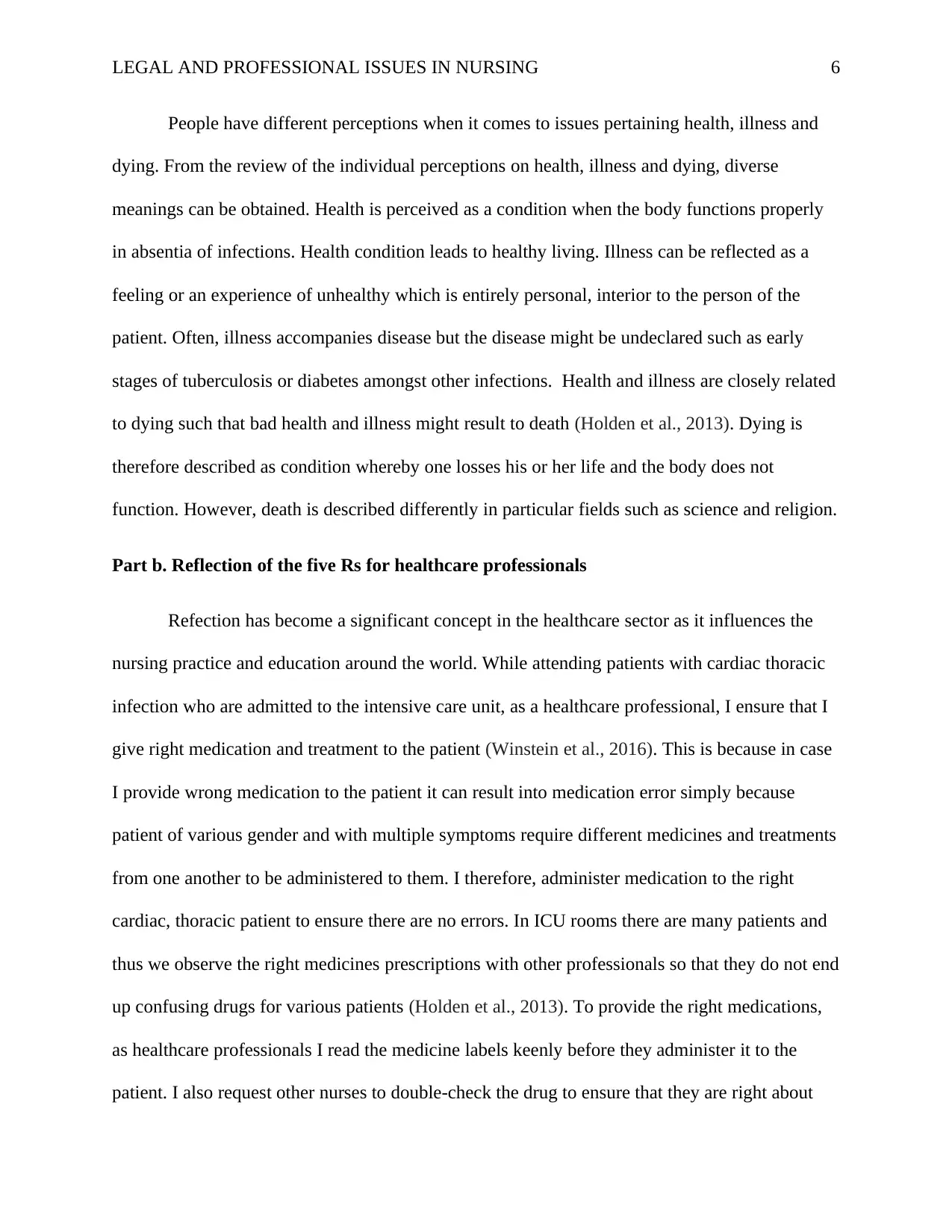
LEGAL AND PROFESSIONAL ISSUES IN NURSING 6
People have different perceptions when it comes to issues pertaining health, illness and
dying. From the review of the individual perceptions on health, illness and dying, diverse
meanings can be obtained. Health is perceived as a condition when the body functions properly
in absentia of infections. Health condition leads to healthy living. Illness can be reflected as a
feeling or an experience of unhealthy which is entirely personal, interior to the person of the
patient. Often, illness accompanies disease but the disease might be undeclared such as early
stages of tuberculosis or diabetes amongst other infections. Health and illness are closely related
to dying such that bad health and illness might result to death (Holden et al., 2013). Dying is
therefore described as condition whereby one losses his or her life and the body does not
function. However, death is described differently in particular fields such as science and religion.
Part b. Reflection of the five Rs for healthcare professionals
Refection has become a significant concept in the healthcare sector as it influences the
nursing practice and education around the world. While attending patients with cardiac thoracic
infection who are admitted to the intensive care unit, as a healthcare professional, I ensure that I
give right medication and treatment to the patient (Winstein et al., 2016). This is because in case
I provide wrong medication to the patient it can result into medication error simply because
patient of various gender and with multiple symptoms require different medicines and treatments
from one another to be administered to them. I therefore, administer medication to the right
cardiac, thoracic patient to ensure there are no errors. In ICU rooms there are many patients and
thus we observe the right medicines prescriptions with other professionals so that they do not end
up confusing drugs for various patients (Holden et al., 2013). To provide the right medications,
as healthcare professionals I read the medicine labels keenly before they administer it to the
patient. I also request other nurses to double-check the drug to ensure that they are right about
People have different perceptions when it comes to issues pertaining health, illness and
dying. From the review of the individual perceptions on health, illness and dying, diverse
meanings can be obtained. Health is perceived as a condition when the body functions properly
in absentia of infections. Health condition leads to healthy living. Illness can be reflected as a
feeling or an experience of unhealthy which is entirely personal, interior to the person of the
patient. Often, illness accompanies disease but the disease might be undeclared such as early
stages of tuberculosis or diabetes amongst other infections. Health and illness are closely related
to dying such that bad health and illness might result to death (Holden et al., 2013). Dying is
therefore described as condition whereby one losses his or her life and the body does not
function. However, death is described differently in particular fields such as science and religion.
Part b. Reflection of the five Rs for healthcare professionals
Refection has become a significant concept in the healthcare sector as it influences the
nursing practice and education around the world. While attending patients with cardiac thoracic
infection who are admitted to the intensive care unit, as a healthcare professional, I ensure that I
give right medication and treatment to the patient (Winstein et al., 2016). This is because in case
I provide wrong medication to the patient it can result into medication error simply because
patient of various gender and with multiple symptoms require different medicines and treatments
from one another to be administered to them. I therefore, administer medication to the right
cardiac, thoracic patient to ensure there are no errors. In ICU rooms there are many patients and
thus we observe the right medicines prescriptions with other professionals so that they do not end
up confusing drugs for various patients (Holden et al., 2013). To provide the right medications,
as healthcare professionals I read the medicine labels keenly before they administer it to the
patient. I also request other nurses to double-check the drug to ensure that they are right about
⊘ This is a preview!⊘
Do you want full access?
Subscribe today to unlock all pages.

Trusted by 1+ million students worldwide
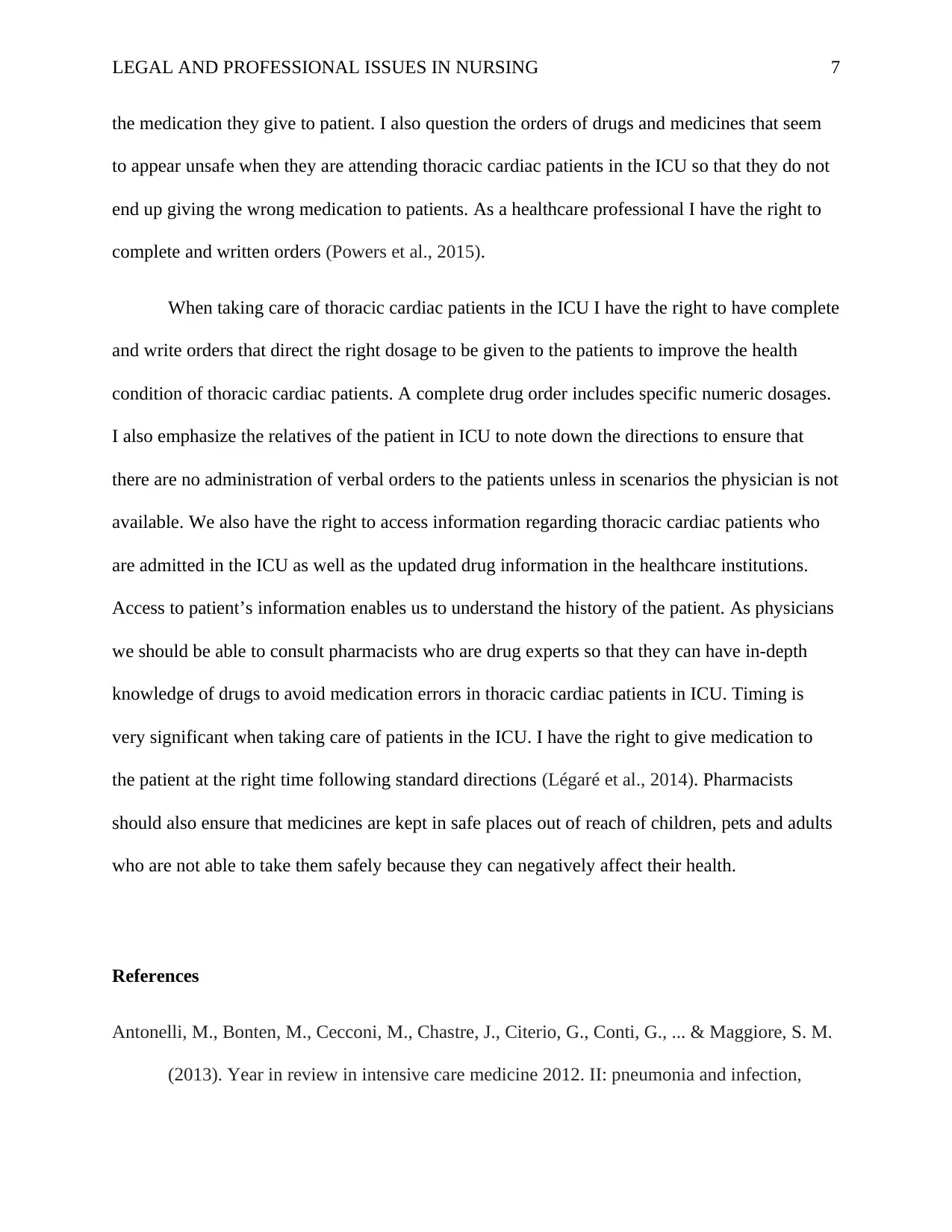
LEGAL AND PROFESSIONAL ISSUES IN NURSING 7
the medication they give to patient. I also question the orders of drugs and medicines that seem
to appear unsafe when they are attending thoracic cardiac patients in the ICU so that they do not
end up giving the wrong medication to patients. As a healthcare professional I have the right to
complete and written orders (Powers et al., 2015).
When taking care of thoracic cardiac patients in the ICU I have the right to have complete
and write orders that direct the right dosage to be given to the patients to improve the health
condition of thoracic cardiac patients. A complete drug order includes specific numeric dosages.
I also emphasize the relatives of the patient in ICU to note down the directions to ensure that
there are no administration of verbal orders to the patients unless in scenarios the physician is not
available. We also have the right to access information regarding thoracic cardiac patients who
are admitted in the ICU as well as the updated drug information in the healthcare institutions.
Access to patient’s information enables us to understand the history of the patient. As physicians
we should be able to consult pharmacists who are drug experts so that they can have in-depth
knowledge of drugs to avoid medication errors in thoracic cardiac patients in ICU. Timing is
very significant when taking care of patients in the ICU. I have the right to give medication to
the patient at the right time following standard directions (Légaré et al., 2014). Pharmacists
should also ensure that medicines are kept in safe places out of reach of children, pets and adults
who are not able to take them safely because they can negatively affect their health.
References
Antonelli, M., Bonten, M., Cecconi, M., Chastre, J., Citerio, G., Conti, G., ... & Maggiore, S. M.
(2013). Year in review in intensive care medicine 2012. II: pneumonia and infection,
the medication they give to patient. I also question the orders of drugs and medicines that seem
to appear unsafe when they are attending thoracic cardiac patients in the ICU so that they do not
end up giving the wrong medication to patients. As a healthcare professional I have the right to
complete and written orders (Powers et al., 2015).
When taking care of thoracic cardiac patients in the ICU I have the right to have complete
and write orders that direct the right dosage to be given to the patients to improve the health
condition of thoracic cardiac patients. A complete drug order includes specific numeric dosages.
I also emphasize the relatives of the patient in ICU to note down the directions to ensure that
there are no administration of verbal orders to the patients unless in scenarios the physician is not
available. We also have the right to access information regarding thoracic cardiac patients who
are admitted in the ICU as well as the updated drug information in the healthcare institutions.
Access to patient’s information enables us to understand the history of the patient. As physicians
we should be able to consult pharmacists who are drug experts so that they can have in-depth
knowledge of drugs to avoid medication errors in thoracic cardiac patients in ICU. Timing is
very significant when taking care of patients in the ICU. I have the right to give medication to
the patient at the right time following standard directions (Légaré et al., 2014). Pharmacists
should also ensure that medicines are kept in safe places out of reach of children, pets and adults
who are not able to take them safely because they can negatively affect their health.
References
Antonelli, M., Bonten, M., Cecconi, M., Chastre, J., Citerio, G., Conti, G., ... & Maggiore, S. M.
(2013). Year in review in intensive care medicine 2012. II: pneumonia and infection,
Paraphrase This Document
Need a fresh take? Get an instant paraphrase of this document with our AI Paraphraser
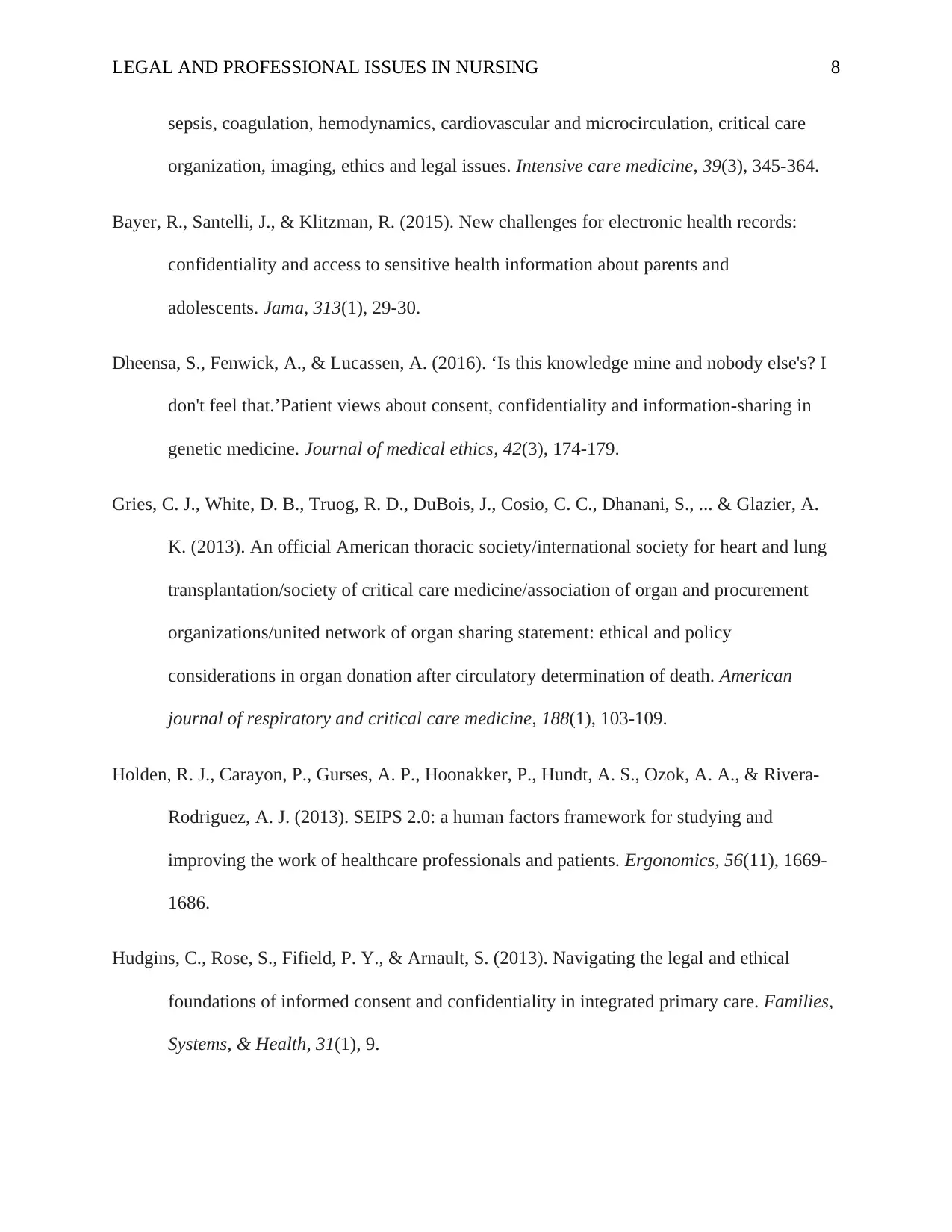
LEGAL AND PROFESSIONAL ISSUES IN NURSING 8
sepsis, coagulation, hemodynamics, cardiovascular and microcirculation, critical care
organization, imaging, ethics and legal issues. Intensive care medicine, 39(3), 345-364.
Bayer, R., Santelli, J., & Klitzman, R. (2015). New challenges for electronic health records:
confidentiality and access to sensitive health information about parents and
adolescents. Jama, 313(1), 29-30.
Dheensa, S., Fenwick, A., & Lucassen, A. (2016). ‘Is this knowledge mine and nobody else's? I
don't feel that.’Patient views about consent, confidentiality and information-sharing in
genetic medicine. Journal of medical ethics, 42(3), 174-179.
Gries, C. J., White, D. B., Truog, R. D., DuBois, J., Cosio, C. C., Dhanani, S., ... & Glazier, A.
K. (2013). An official American thoracic society/international society for heart and lung
transplantation/society of critical care medicine/association of organ and procurement
organizations/united network of organ sharing statement: ethical and policy
considerations in organ donation after circulatory determination of death. American
journal of respiratory and critical care medicine, 188(1), 103-109.
Holden, R. J., Carayon, P., Gurses, A. P., Hoonakker, P., Hundt, A. S., Ozok, A. A., & Rivera-
Rodriguez, A. J. (2013). SEIPS 2.0: a human factors framework for studying and
improving the work of healthcare professionals and patients. Ergonomics, 56(11), 1669-
1686.
Hudgins, C., Rose, S., Fifield, P. Y., & Arnault, S. (2013). Navigating the legal and ethical
foundations of informed consent and confidentiality in integrated primary care. Families,
Systems, & Health, 31(1), 9.
sepsis, coagulation, hemodynamics, cardiovascular and microcirculation, critical care
organization, imaging, ethics and legal issues. Intensive care medicine, 39(3), 345-364.
Bayer, R., Santelli, J., & Klitzman, R. (2015). New challenges for electronic health records:
confidentiality and access to sensitive health information about parents and
adolescents. Jama, 313(1), 29-30.
Dheensa, S., Fenwick, A., & Lucassen, A. (2016). ‘Is this knowledge mine and nobody else's? I
don't feel that.’Patient views about consent, confidentiality and information-sharing in
genetic medicine. Journal of medical ethics, 42(3), 174-179.
Gries, C. J., White, D. B., Truog, R. D., DuBois, J., Cosio, C. C., Dhanani, S., ... & Glazier, A.
K. (2013). An official American thoracic society/international society for heart and lung
transplantation/society of critical care medicine/association of organ and procurement
organizations/united network of organ sharing statement: ethical and policy
considerations in organ donation after circulatory determination of death. American
journal of respiratory and critical care medicine, 188(1), 103-109.
Holden, R. J., Carayon, P., Gurses, A. P., Hoonakker, P., Hundt, A. S., Ozok, A. A., & Rivera-
Rodriguez, A. J. (2013). SEIPS 2.0: a human factors framework for studying and
improving the work of healthcare professionals and patients. Ergonomics, 56(11), 1669-
1686.
Hudgins, C., Rose, S., Fifield, P. Y., & Arnault, S. (2013). Navigating the legal and ethical
foundations of informed consent and confidentiality in integrated primary care. Families,
Systems, & Health, 31(1), 9.
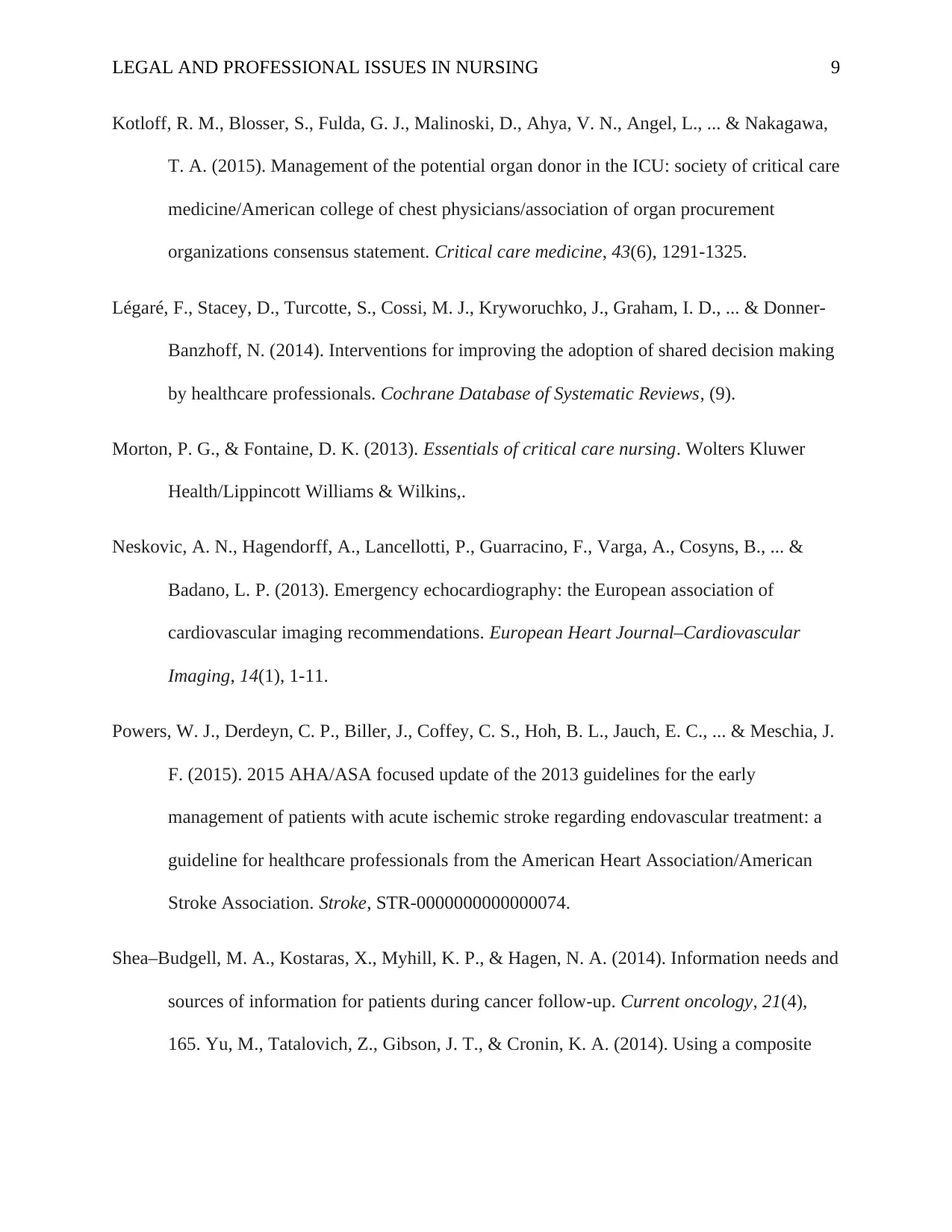
LEGAL AND PROFESSIONAL ISSUES IN NURSING 9
Kotloff, R. M., Blosser, S., Fulda, G. J., Malinoski, D., Ahya, V. N., Angel, L., ... & Nakagawa,
T. A. (2015). Management of the potential organ donor in the ICU: society of critical care
medicine/American college of chest physicians/association of organ procurement
organizations consensus statement. Critical care medicine, 43(6), 1291-1325.
Légaré, F., Stacey, D., Turcotte, S., Cossi, M. J., Kryworuchko, J., Graham, I. D., ... & Donner‐
Banzhoff, N. (2014). Interventions for improving the adoption of shared decision making
by healthcare professionals. Cochrane Database of Systematic Reviews, (9).
Morton, P. G., & Fontaine, D. K. (2013). Essentials of critical care nursing. Wolters Kluwer
Health/Lippincott Williams & Wilkins,.
Neskovic, A. N., Hagendorff, A., Lancellotti, P., Guarracino, F., Varga, A., Cosyns, B., ... &
Badano, L. P. (2013). Emergency echocardiography: the European association of
cardiovascular imaging recommendations. European Heart Journal–Cardiovascular
Imaging, 14(1), 1-11.
Powers, W. J., Derdeyn, C. P., Biller, J., Coffey, C. S., Hoh, B. L., Jauch, E. C., ... & Meschia, J.
F. (2015). 2015 AHA/ASA focused update of the 2013 guidelines for the early
management of patients with acute ischemic stroke regarding endovascular treatment: a
guideline for healthcare professionals from the American Heart Association/American
Stroke Association. Stroke, STR-0000000000000074.
Shea–Budgell, M. A., Kostaras, X., Myhill, K. P., & Hagen, N. A. (2014). Information needs and
sources of information for patients during cancer follow-up. Current oncology, 21(4),
165. Yu, M., Tatalovich, Z., Gibson, J. T., & Cronin, K. A. (2014). Using a composite
Kotloff, R. M., Blosser, S., Fulda, G. J., Malinoski, D., Ahya, V. N., Angel, L., ... & Nakagawa,
T. A. (2015). Management of the potential organ donor in the ICU: society of critical care
medicine/American college of chest physicians/association of organ procurement
organizations consensus statement. Critical care medicine, 43(6), 1291-1325.
Légaré, F., Stacey, D., Turcotte, S., Cossi, M. J., Kryworuchko, J., Graham, I. D., ... & Donner‐
Banzhoff, N. (2014). Interventions for improving the adoption of shared decision making
by healthcare professionals. Cochrane Database of Systematic Reviews, (9).
Morton, P. G., & Fontaine, D. K. (2013). Essentials of critical care nursing. Wolters Kluwer
Health/Lippincott Williams & Wilkins,.
Neskovic, A. N., Hagendorff, A., Lancellotti, P., Guarracino, F., Varga, A., Cosyns, B., ... &
Badano, L. P. (2013). Emergency echocardiography: the European association of
cardiovascular imaging recommendations. European Heart Journal–Cardiovascular
Imaging, 14(1), 1-11.
Powers, W. J., Derdeyn, C. P., Biller, J., Coffey, C. S., Hoh, B. L., Jauch, E. C., ... & Meschia, J.
F. (2015). 2015 AHA/ASA focused update of the 2013 guidelines for the early
management of patients with acute ischemic stroke regarding endovascular treatment: a
guideline for healthcare professionals from the American Heart Association/American
Stroke Association. Stroke, STR-0000000000000074.
Shea–Budgell, M. A., Kostaras, X., Myhill, K. P., & Hagen, N. A. (2014). Information needs and
sources of information for patients during cancer follow-up. Current oncology, 21(4),
165. Yu, M., Tatalovich, Z., Gibson, J. T., & Cronin, K. A. (2014). Using a composite
⊘ This is a preview!⊘
Do you want full access?
Subscribe today to unlock all pages.

Trusted by 1+ million students worldwide
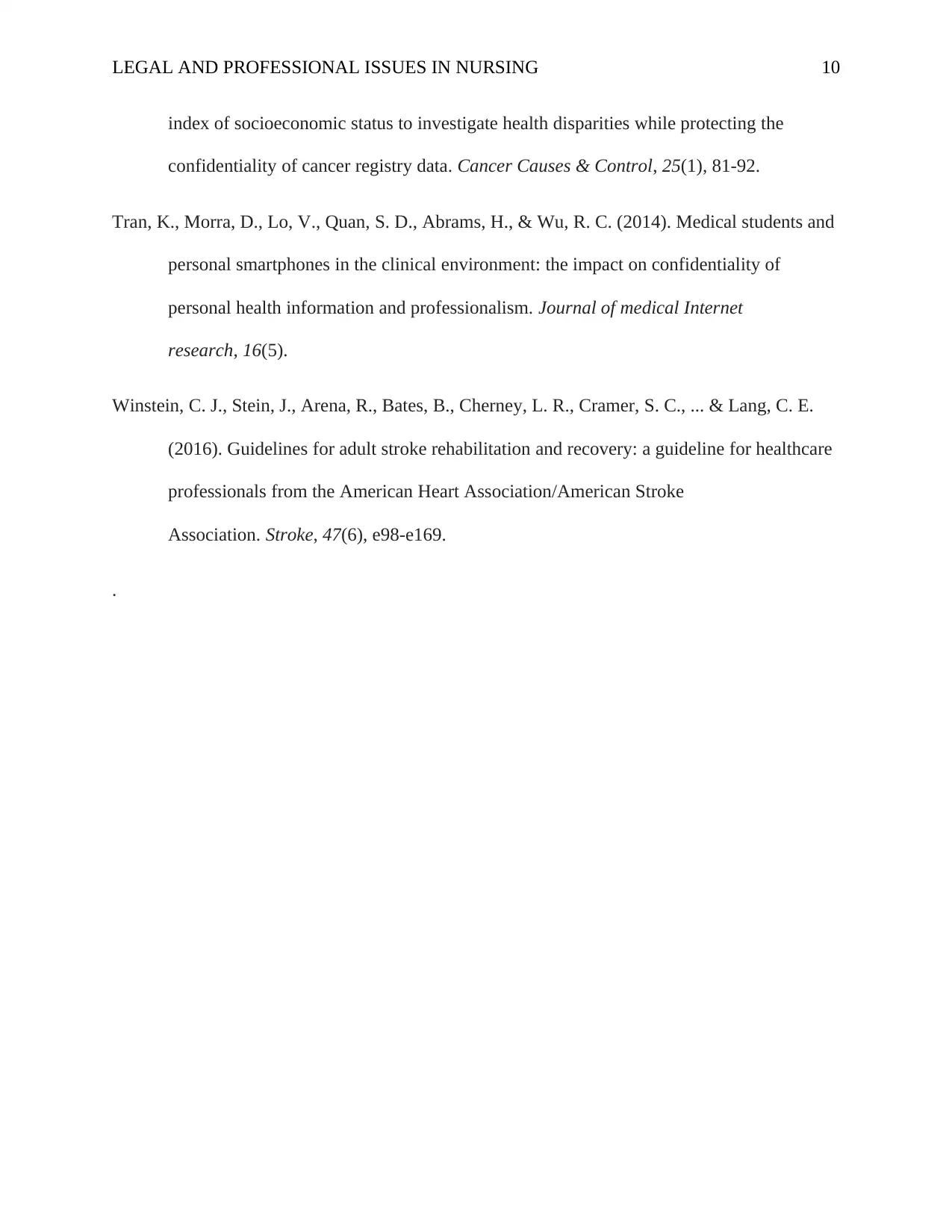
LEGAL AND PROFESSIONAL ISSUES IN NURSING 10
index of socioeconomic status to investigate health disparities while protecting the
confidentiality of cancer registry data. Cancer Causes & Control, 25(1), 81-92.
Tran, K., Morra, D., Lo, V., Quan, S. D., Abrams, H., & Wu, R. C. (2014). Medical students and
personal smartphones in the clinical environment: the impact on confidentiality of
personal health information and professionalism. Journal of medical Internet
research, 16(5).
Winstein, C. J., Stein, J., Arena, R., Bates, B., Cherney, L. R., Cramer, S. C., ... & Lang, C. E.
(2016). Guidelines for adult stroke rehabilitation and recovery: a guideline for healthcare
professionals from the American Heart Association/American Stroke
Association. Stroke, 47(6), e98-e169.
.
index of socioeconomic status to investigate health disparities while protecting the
confidentiality of cancer registry data. Cancer Causes & Control, 25(1), 81-92.
Tran, K., Morra, D., Lo, V., Quan, S. D., Abrams, H., & Wu, R. C. (2014). Medical students and
personal smartphones in the clinical environment: the impact on confidentiality of
personal health information and professionalism. Journal of medical Internet
research, 16(5).
Winstein, C. J., Stein, J., Arena, R., Bates, B., Cherney, L. R., Cramer, S. C., ... & Lang, C. E.
(2016). Guidelines for adult stroke rehabilitation and recovery: a guideline for healthcare
professionals from the American Heart Association/American Stroke
Association. Stroke, 47(6), e98-e169.
.
1 out of 10
Related Documents
Your All-in-One AI-Powered Toolkit for Academic Success.
+13062052269
info@desklib.com
Available 24*7 on WhatsApp / Email
![[object Object]](/_next/static/media/star-bottom.7253800d.svg)
Unlock your academic potential
Copyright © 2020–2025 A2Z Services. All Rights Reserved. Developed and managed by ZUCOL.





